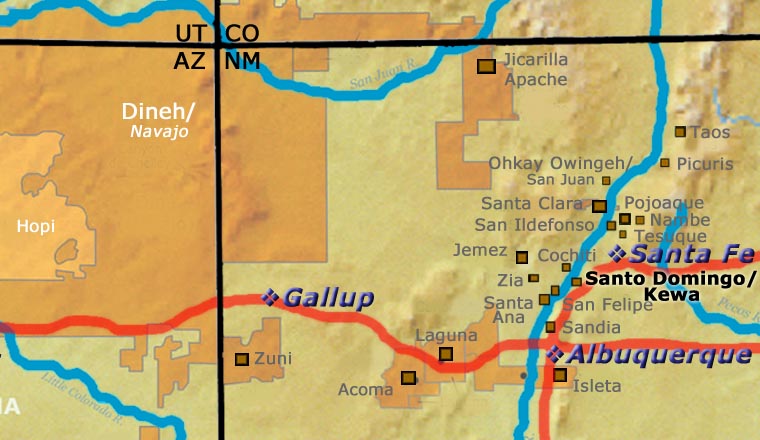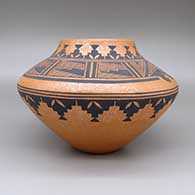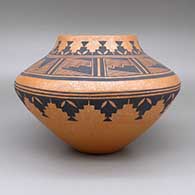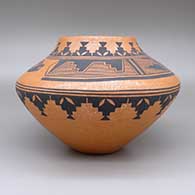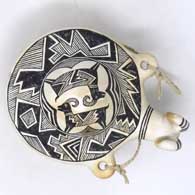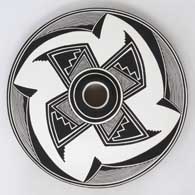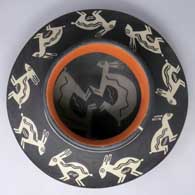
Mark Wayne Garcia
Santo Domingo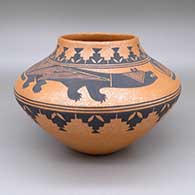
Mark Wayne Garcia is a traditional Santo Domingo Pueblo potter. He began his career in the 1990s making black-on-red dough bowls, canteens and jars. When he switched to painting black designs on golden micaceous clay pieces, his career really took off.
It seems he lives and works in the Los Angeles area now and comes to Santo Domingo only to fire and sell his pottery, and collect more clay.
100 West San Francisco Street, Santa Fe, New Mexico 87501
(505) 986-1234 - www.andreafisherpottery.com - All Rights Reserved

Santo Domingo Pueblo
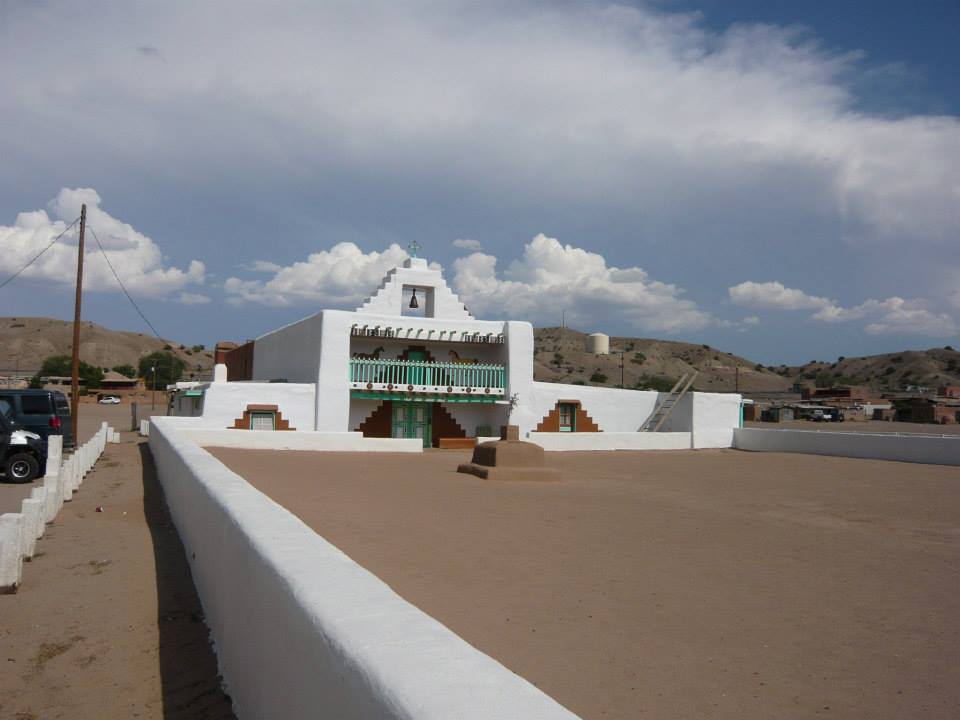
Santo Domingo Pueblo Mission Church
Santo Domingo Pueblo is located on the east bank of the Rio Grande about half-way between Santa Fe and Albuquerque. Historically, the people of Santo Domingo were among the most active of Pueblo traders. The pueblo also has a reputation of being ultra traditional, probably due, at least in part, to the longevity of the pueblo's pottery styles. Some of today's popular designs have changed very little since the 1700s.
In pre-Columbian times, traders from Santo Domingo were trading turquoise (from mines in the Cerrillos Hills) and hand-made heishe beads as far away as central Mexico. Many artisans in the pueblo still work in the old ways and produce wonderful silver and turquoise jewelry and heishe decorations.
Like the people of nearby San Felipe and Cochiti, the people of Santo Domingo speak Keres and trace their ancestry back to villages established in the Pajarito Plateau area in the 1400's. Like the other Rio Grande pueblos, Santo Domingo rose up against the Spanish oppressors in 1680, following Alonzo Catiti as he led the Keres-speaking pueblos and worked with Popé (of San Juan Pueblo) to stop the Spanish atrocities. However, when Spanish Governor Antonio Otermin returned to the area in 1681, he found Santo Domingo deserted and ordered it burned. The pueblo residents had fled to a nearby mountain stronghold and when Don Diego de Vargas returned to Nuevo Mexico in 1692, he attacked that mountain fortress and burned it, too. Catiti died in that battle and Keres opposition to the Spanish crumbled with his death. The survivors of that battle fled, some to Acoma, some to fledgling Laguna, some to the Hopi mesas. Over time most of them returned to Santo Domingo.
In the 1790s Santo Domingo accepted an influx of refugees from the Galisteo Basin area as they fled the near-constant attacks of Apache, Comanche, Ute and Navajo raiders in that area. Today's main Santo Domingo village was founded about 1886.
In 1598 Santo Domingo was the site of the first gathering of 38 pueblo governors by Don Juan de Oñaté to try to force them to swear allegiance to the crown of Spain. Today, the All Indian Pueblo Council (consisting of the nineteen remaining pueblo's governors and an executive staff) gathers at Santo Domingo for their first meeting every year, to continue what is now the oldest annual political gathering in America. During the time of the Spanish occupation Santo Domingo served as the headquarters of the Franciscan missionaries in New Mexico and religious trials were held there during the Spanish Inquisition.
Today, the people of Santo Domingo number around 4,500, with about two-thirds of them living on the reservation. The pottery traditions of the pueblo almost died out after the railroads arrived and many Santo Domingos went to work laying tracks. Even today many Santo Domingo men work as firefighters for the US Forest Service in fire season and ply their artistic talents during the rest of the year.
Potter Robert Tenorio began working to revive the Santo Domingo pottery tradition in the early 1970s. His influence can be found among many of today's Santo Domingo potters, even if they say he stimulated them to learn on their own.
While today's Santo Domingo pottery is known for designs described as simple geometrics, another outstanding feature is boldness: the lines are thick and well-defined.
As religious leaders forbid the representation of human figures as well as other sacred designs on pottery made for commercial purposes, birds, fish and flowers are common design motifs. Depictions of mammals are rarely seen. Another typical Santo Domingo style is to paint in the negative, meaning cover the pot in panels of big swatches of black and red so that only a few lines of the cream slip show through.
100 West San Francisco Street, Santa Fe, New Mexico 87501
(505) 986-1234 - www.andreafisherpottery.com - All Rights Reserved

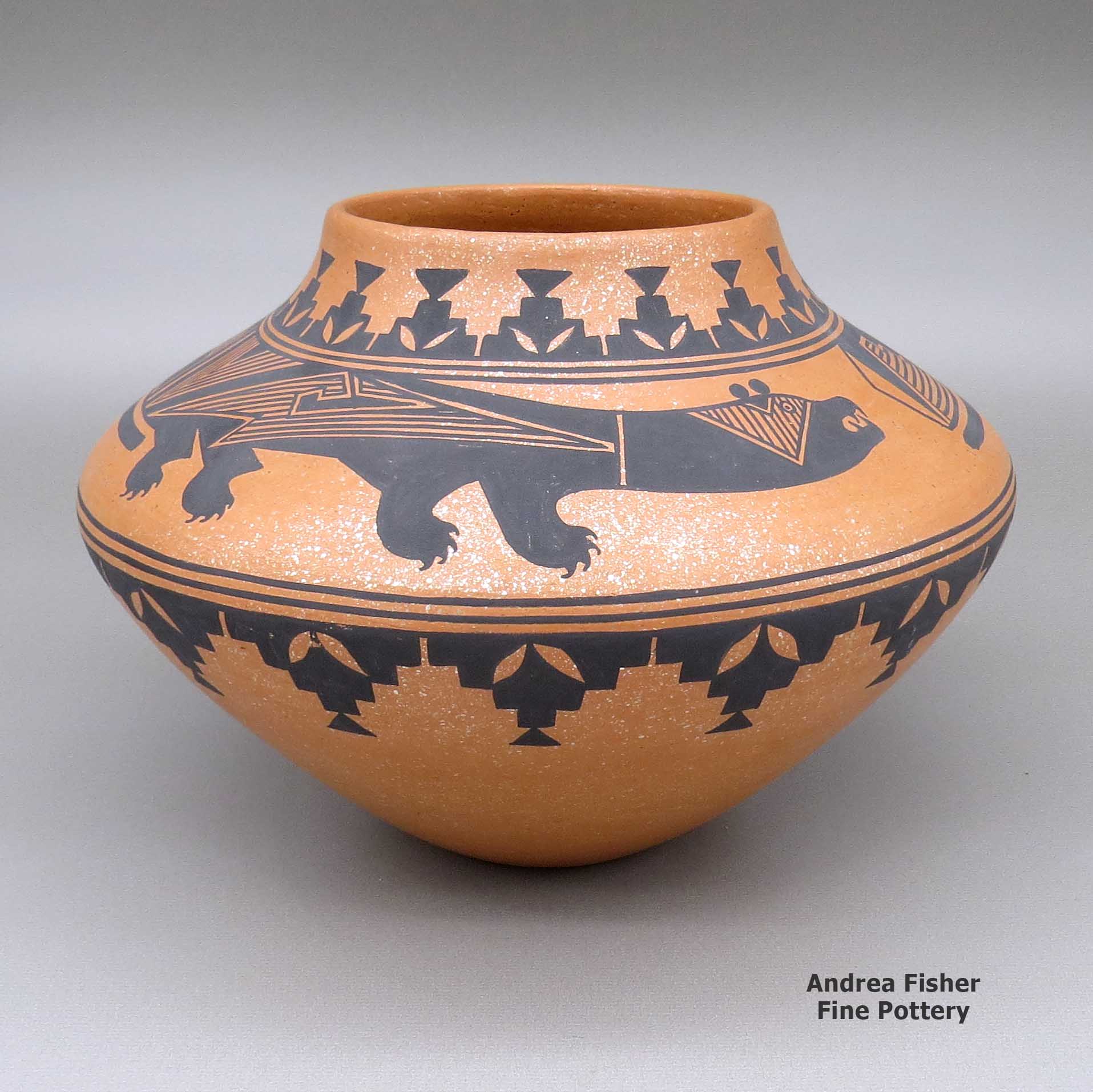
Mark Wayne Garcia, Santo_Domingo, MicaceousgoldandblackjarwithapaintedMimbresbear,kivastep,andgeometricdesign
Santo Domingo
$ 495
mgsd3f269
Micaceous gold and black jar with a painted Mimbres bear, kiva step, and geometric design
9 in L by 9 in W by 9.25 in H
Condition: Very good, rubbing on bottom and scratches
Signature: Mark Wayne Garcia Santo Domingo Pueblo, with hallmark
100 West San Francisco Street, Santa Fe, New Mexico 87501
(505) 986-1234 - www.andreafisherpottery.com - All Rights Reserved

Mimbres Pottery
Mimbres Mogollon Culture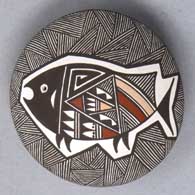
Rebecca Lucario
Acoma

Verda Toledo
Jemez
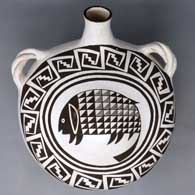
Marie Z. Chino
Acoma
The Mimbres Mogollon culture was named for the Mimbres River in the Gila Mountains. They lived in the area from about 850 CE to about 1150 CE. Substantial depopulation of the area occurred but there were many small surviving populations. Over time, these melted into the surrounding cultures with many families moving north to Acoma, Zuni and Hopi while others moved south to Casas Grande and Paquimé.
The time period from about 850 CE to about 1000 CE is classed the Late Basketmaker III period. The time period was characterized by the evolution of square and rectangular pithouses with plastered floors and walls. Ceremonial structures were generally dug deep into the ground. Local forms of pottery have been classified as early Mimbres black-on-white (formerly Boldface Black-on-White), textured plainware and red-on-cream.
The Classic Mimbres phase (1000 CE to 1150 CE) was marked with the construction of larger buildings in clusters of communities around open plazas. Some constructions had up to 150 rooms. Most groupings of rooms included a ceremonial room, although smaller square or rectangular underground kivas with roof openings were also being used. Classic Mimbres settlements were located in areas with well-watered floodplains available, suitable for the growing of maize, squash and beans. The villages were limited in size by the ability of the local area to grow enough food to support the village.
Pottery produced in the Mimbres region is distinct in style and decoration. Early Mimbres black-on-white pottery was primarily decorated with bold geometric designs, although some early pieces show human and animal figures. Over time the rendering of figurative and geometric designs grew more refined, sophisticated and diverse, suggesting community prosperity and a rich ceremonial life. Classic Mimbres black-on-white pottery is also characterized by bold geometric shapes but done with refined brushwork and very fine linework. Designs may include figures of one or multiple humans, animals or other shapes, bounded by either geometric decorations or by simple rim bands. A common figure on a Mimbres pot is the turkey, another is the thunderbird. There are also a lot of different fish depicted, some are species found in the Gulf of California.
A lot of Mimbres bowls (with kill holes) have been found in archaeological excavations but most Mimbres pottery shows evidence it was actually used in day-to-day life and wasn't produced just for burial purposes.
There's a lot of speculation as to what happened to the Mimbres people as their countryside was rapidly depopulated after about 1150 CE. The people of Isleta, Acoma and Laguna find ancient Mimbres pot shards on their pueblo lands, indicating that pottery designs from the Mimbres River area migrated north. There are similar designs found on pot shards littering the ground around Casas Grandes and Paquime near Mata Ortiz and Nuevo Casas Grandes in northern Mexico. Other than where they went, the only reasons offered for why they left involve at least small scale climate change. The usual comment is "drought" but drought could have been brought on by the eruption of a volcano on the other side of the planet, or a small change in the El Nino-La Nina schedule. Whatever it was that started the outflow of people, it began in the Mimbres River area and spread outward from there. Excavations in the Eastern Mimbres region (nearer to Truth or Consequences, New Mexico) have shown that the people adapted to new circumstances and that adaptation itself moved them closer into alignment with surrounding tribes and cultures. Eventually they just kind of merged into the background, although the groups that moved south and built up Paquime and Casas Grandes seem to have lost a war and survivors migrated to the west, to a land a bit more hospitable for them.
100 West San Francisco Street, Santa Fe, New Mexico 87501
(505) 986-1234 - www.andreafisherpottery.com - All Rights Reserved
